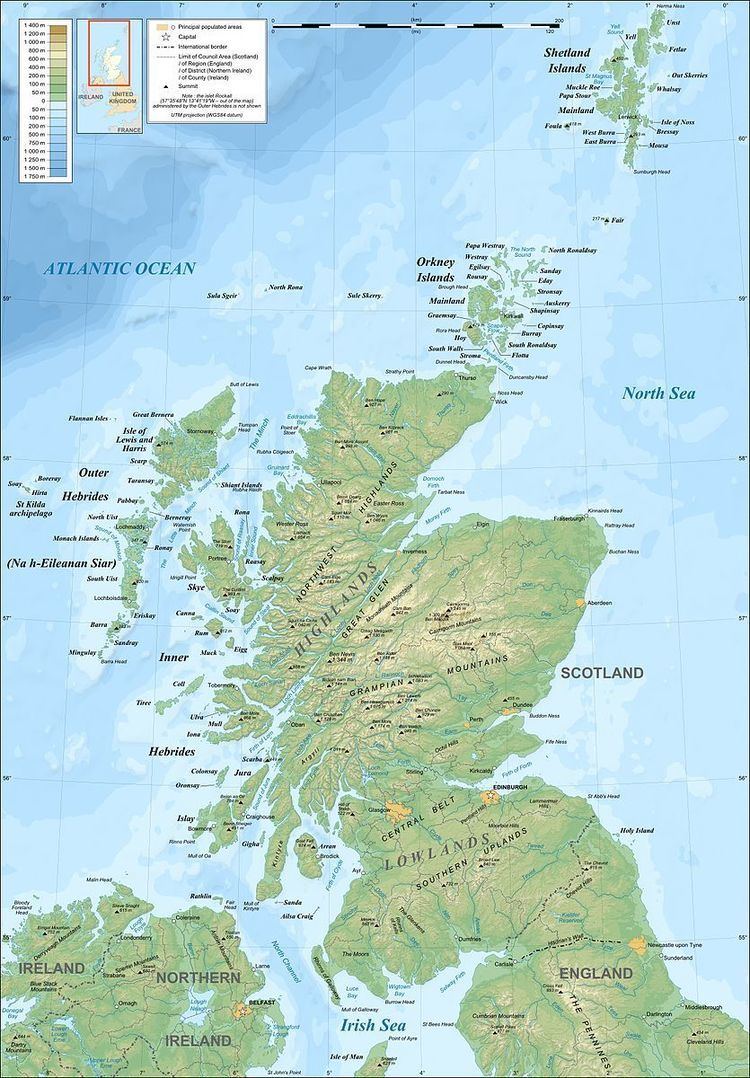 | ||
The outlying islands of Scotland incorporate those that are not part of the larger archipelagos and island groups of Scotland and are thus not listed as being part of the Hebrides, the Northern Isles or the Islands of the Forth and Clyde estuaries. None of these islands are currently inhabited and few of them ever were, although Hirta was occupied from the Neolithic age until 1930 and Stroma was permanently occupied until the 1970s and thereafter by lighthouse keepers and their families until 1996. Several other outlying islands have lighthouses, none of which are still manned.
Contents
In this list, an island is defined as "land that is surrounded by seawater on a daily basis, but not necessarily at all stages of the tide, excluding human devices such as bridges and causeways". A complication relating to membership of this list is that there are various descriptions of the scope of the Hebrides, the large group of islands that lie off Scotland's west coast. The Collins Encyclopedia of Scotland describes the Inner Hebrides as lying "east of The Minch", which would include any and all offshore islands. There are various islands that lie in the sea lochs such as Eilean Bàn and Eilean Donan that might not ordinarily be described as "Hebridean" but no formal definitions exist and for simplicity they are included in the List of Inner Hebrides rather than here.
Main islands
There are several small groupings of outlying islands involved. The most significant of these is the St Kilda archipelago which lies 64 kilometres (40 mi) west-northwest of North Uist and is now a World Heritage Site. It is one of the few to hold joint status for its natural and cultural qualities. At 196 metres (643 ft) Stac an Armin is the highest sea stack in the British Isles and in July 1840, the last great auk seen in the British Isles was captured there.
East of St Kilda are the Flannan Isles, the location of an enduring mystery which occurred in December 1900, when all three lighthouse keepers vanished without trace. Further north and east are the two outliers of Sula Sgeir and North Rona, which have strong cultural links to the Outer Hebrides. North Rona is 71 kilometres (44 mi) north north east of Butt of Lewis and 18 kilometres (11 mi) east of Sula Sgeir. It is the remotest island in the British Isles to have ever been inhabited on a long-term basis. It is also closer than any other part of Scotland to the Faroe Islands. Sule Skerry and Sule Stack lie further east and are administratively part of Orkney.
The islands of the north coast are remote from the main centres of population, although for the most part lie close to the shores of the mainland. There is a small group of larger islands near Tongue Bay but the largest on this coast is Stroma in the Pentland Firth, which lies between Caithness and Orkney. Innis Mhòr in the Dornoch Firth is the largest of a handful of small islets off the coast of Easter Ross. Further south are Inchcape off the coast of Angus, and Mugdrum, the only substantial island in the Firth of Tay. There is a cluster of islands in the Solway Firth that marks the south western border of Scotland, including the Islands of Fleet, in Wigtown Bay.
Most of the smaller islets that surround those in the main list are obscure and none have ever been permanently inhabited in modern times. Nonetheless, some have a degree of historical significance. Castle Mestag off Stroma is the ruins of a once fortified stack accessible only via a drawbridge. Some islets are identified as "storm washed" meaning that, although a proportion of their bulk remains above mean sea level, large waves wash over the top of them during storms, rendering them uninhabitable.
Finally, there is isolated Rockall, which is 367 kilometres (228 mi) to the west of North Uist. It is a small rocky islet in the North Atlantic which could be, in James Fisher's words, "the most isolated small rock in the oceans of the world" and which was declared part of Scotland by the Island of Rockall Act 1972. However, the legality of the claim is disputed by the Republic of Ireland, Denmark and Iceland and it is probably unenforceable in international law.
Smaller islets off the mainland
There are various smaller islets and skerries that are only exposed at lower stages of the tide in the seas surrounding the mainland of Scotland. Craiglethy is part of the Fowlsheugh nature reserve. The Three Kings, off the coast of Easter Ross near Balintore, is also known as Creag Harail or Harold's Rock and called The King's Sons in the New Statistical Account of Scotland. According to legend, three sons of a Danish prince, sailing to avenge their sister's wrongs, were wrecked here and gave these rocks their collective name. Their graves were marked by the sculptured stones of Nigg, Shandwick and Hilton of Cadboll. Another story has their burial at Nigg Rocks below the North Sutor.
Other than Mugdrum in the Firth of Tay and the Islands of the Forth there are no genuine islands on the east coast of Scotland south of Buddon Ness.
